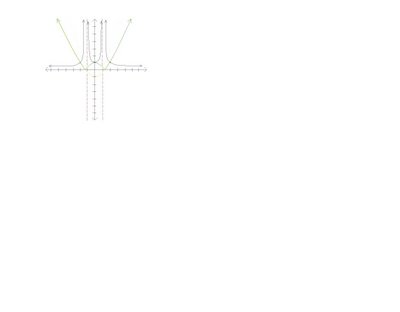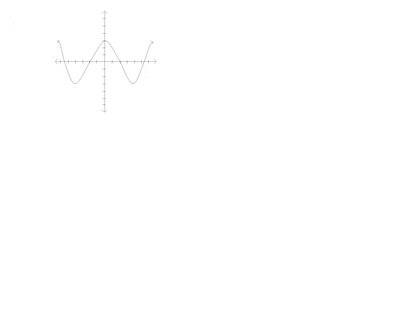Scribe post: Transformations
Hello guys! I'm Daphne and I'm the scribe for today. On our second period pre-calculus, we did some exercises about transformation. First, Mr. K gave us an equation needed to be solved by sketching a graph. Second, he gave us word problems that must be equated. Lastly, he gave us an equation that must be answered by a process on which of the following operation must be done first. Here are the questions we solved in the class.
A) Sketch the graph:
f(x)= 1/x²-1
Steps in the making the graph of f(x) = 1/x²-1
1. Draw the original function x²-1
2. Draw the absolute function. Move your negative y values to the positive y values.
3. Look for roots/ zeros/ x-intercept and draw your asymptotes.
4. Look on the graph for -1 and 1 and draw the anchors.
5. When the points are plotted, all the arrows that have decreasing numbers will be changed to increasing values and all the arrows that have increasing numbers will be changed to decreasing values.
B) y= f(x)
Write the formula for each set of transforamtions done to y
1. translate 2 units right
Answer: y= f(x-2)
2. Compress the graph horizontally by a factor of 5
Answer: y=f(5x)
3. Stretch the graph horizontally by a factor of 2 and translate 3 units down.
Answer: f((1/2)x)-3
4. Reflect the graph in the y-axis and strecth it vertically by a factor of 3
Answer: y= 3f(-x)
C) y= f(2x-4)+1
Make the procedure on this equation and identify which operation will go first in graphing this.
1. Stretch the graph vertically by factors of 3
2. Compress the graph horizontally by factors of 2
3. Translate it 4 units to the right
4. Translate it one unit up
After answering a couple of questions, Mr. K told us to compare our answers with our adjacent classmate. We were given 60 seconds to do that. As a result, we came up with the answers written above. Then, we were asked to put out our math dictionaries because a new lesson will be added but before that Mr. K gave us a phrase to remember.
"Stretches first before translations"
MATH DICTIONARY
EVEN FUNCTIONS
Graphically: A function is "even" if its graph is symmetrical about the origin.
The function are eve


These are not
 Symbolically (Algebraically): a function is "even" IFF (if and only if)
Symbolically (Algebraically): a function is "even" IFF (if and only if)
Examples: Are these functions even?
1. f(x)= x²
f(-x)=(-x)²
= x²
since f(-x)=f(x)
f is an even function
2. g(x)= x² + 2x
g(-x)= (-x)² + 2(-x)
= x² - 2x
since g(-x) is not equal to g(x)
g is not an even fucntion
ODD FUNCTIONS
Graphically: A function is "odd" if its graph is symmetrical about the origin.
These functions are odd (if its graph)

 These are not
These are not
 Symbolically (Algebraically): A function is odd IFF (if and only if)
Symbolically (Algebraically): A function is odd IFF (if and only if)f(-x)= -f(x)
Examples:
1. f(x)= x³- x
f(-x)= (-x)³- (-x)
= -x³+ x
f is an odd function
2. g(x)= x³- x²
g(-x)= (-x)³ - (-x)²
= -x³ - x²
-g(x)= (x³-x²)
= -x³+ x²
since g(-x) is not equal to -g(x)
g is not an odd function
IMPORTANT: 1/ f(x) is not equal to f^-1 (x)
 Example:
Example:Sketch the graph f(x) = 1/ x²-4
 THE RECIPROCAL TRIGONONMETRY FUNCTIONS
THE RECIPROCAL TRIGONONMETRY FUNCTIONS
f(x) = cscx
f(x)= 1/ sinx
 f(x)= secx
f(x)= secxf(x)= 1/cosx

f(x)= 1/tanx
 Sketching f(x)
Sketching f(x)STEP 1 Sketch f(x)
STEP 2 Reflect the postion of the graph of f(x) that is below the x-axis above the x-axis.
Example:
Sketch f(x)= x²-4

After writing everything in our Math Dictionary, Mr. K discussed an unfinished discussion about the different seasons in the earth affected by its slanting axis. Well then guys, this is my scribe post and I hope you enjoy viewing my page!!!!!
This was a good post. Your diagrams are small yet the picture takes up a trememdous amount of posting space. If you had time I would crop the images in irfanview or any other image software then repost them. When the images are a smaller size they will not detract from the content of your post.
ReplyDeleteThanks for sharing
Mr. Harbeck
Sargent Park School